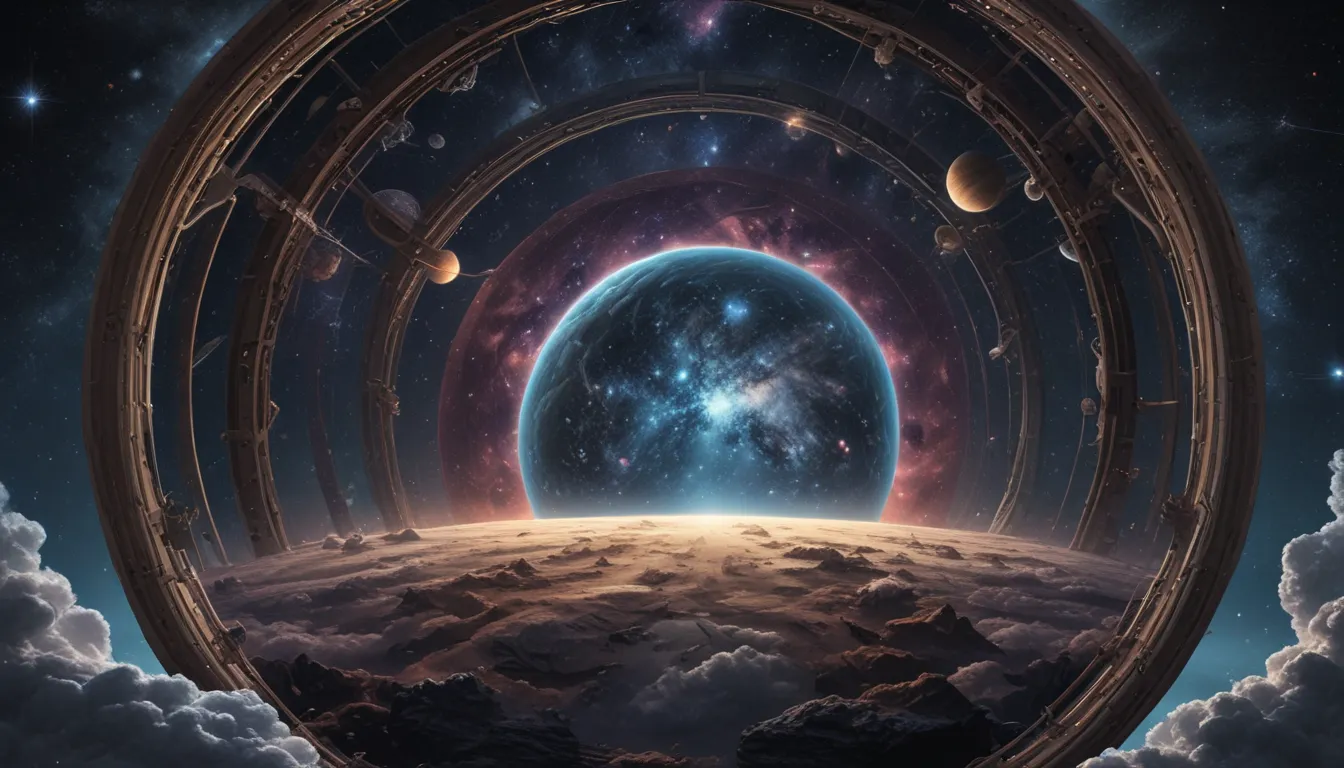The pictures we use in our articles might not show exactly what the words say. We choose these pictures to make you interested in reading more. The pictures work together with the words but don’t take their place. The words still tell you the important facts.
The vast expanse of our Universe is a captivating realm of cosmic beauty and mystery, filled with swirling galaxies, shimmering nebulae, and enigmatic black holes. In this article, we will embark on an awe-inspiring journey through the hidden wonders of cosmic structure, uncovering 19 extraordinary facts that will leave you in awe. Whether you are an avid stargazer or simply curious about the vastness of space, prepare to be amazed by the mind-boggling revelations that await you in the cosmic expanse.
Delving into the Vastness: The Universe and Galaxies
The Universe is a magnificent tapestry woven with billions of galaxies, each containing billions of stars. This vast expanse of cosmic beauty is interconnected through a web of galaxies, black holes, and dark matter, shaping the intricate cosmic structure that dazzles scientists and enthusiasts alike.
Unveiling the Cosmic Web: A Massive Cosmic Structure
At the heart of the Universe lies the cosmic web, a vast interconnected web-like structure formed by galaxies, galaxy clusters, and dark matter filaments. Spanning hundreds of millions of light-years, the cosmic web is a marvel of cosmic architecture that unveils the interconnected nature of the cosmos.
Superclusters: The Giants of the Universe
Superclusters are massive structures that contain numerous galaxy clusters, spanning vast distances in the cosmic landscape. These colossal entities are among the largest known structures in the Universe, captivating astronomers with their sheer size and complexity.
The Enigma of Black Holes: Powerful Cosmic Entities
Black holes are enigmatic cosmic objects with gravitational forces so strong that not even light can escape their grasp. Formed by the collapse of massive stars, black holes are one of the most intriguing phenomena in the cosmos, with supermassive black holes reigning at the centers of galaxies.
Dark Matter: The Invisible Cosmic Force
Dark matter, an invisible substance that makes up a significant portion of the matter in the Universe, plays a crucial role in shaping the large-scale structure of cosmic architecture. Despite its elusiveness, dark matter leaves an indelible mark on the cosmic landscape, influencing the formation of galaxies and clusters.
Cosmic Mysteries Unveiled: From Black Holes to Dark Energy
The observable Universe, estimated to be about 93 billion light-years in diameter, is a realm of cosmic wonders waiting to be explored. From the cosmic microwave background radiation, a remnant of the Big Bang, to the gravitational anomalies like the Great Attractor, the Universe continues to reveal its secrets, captivating our imagination.
Exploring the Cosmic Neighborhood: Galaxies and Clusters
Galaxy clusters, the largest gravitationally bound structures in the Universe, contain hundreds or even thousands of galaxies held together by their collective gravitational pull. The Andromeda Galaxy, on a collision course with our Milky Way Galaxy, offers a glimpse into the dynamic interactions of cosmic structures.
Cosmic Beacons: Quasars and Nebulas
Quasars, extraordinarily bright objects powered by supermassive black holes, illuminate the distant reaches of the Universe with their massive light emissions. Nebulas, vast clouds of gas and dust where new stars are born, serve as celestial nurseries, giving rise to the stellar wonders that dot the cosmic skyline.
Unraveling Dark Energy: A Mysterious Cosmic Force
Dark energy, a mysterious force that accelerates the expansion of the Universe, remains one of the greatest enigmas in physics, constituting a significant portion of the total energy in the cosmic expanse. The Virgo Cluster, the nearest large cluster of galaxies to our Local Group, offers a glimpse into the cosmic neighborhoods that surround us.
The Intricate Dance of Cosmic Structures: Galaxies and Spiral Arms
The Milky Way Galaxy, part of the Local Group cluster of galaxies, showcases the intricate dance of cosmic structures within the cosmic neighborhood. Spiral arms, regions of increased star formation and stellar activity, sculpt the majestic beauty of galaxies, shaping the celestial wonders that grace the cosmic canvas.
Unlocking the Mysteries of the Universe: Cosmic Structure and Evolution
The formation and evolution of cosmic structures are a complex interplay of matter, gravity, and cosmic expansion, shaping the beauty and vastness of our Universe. From the cosmic web connecting galaxies to the cosmic voids that punctuate the cosmic landscape, each element contributes to the rich tapestry of cosmic architecture that continues to captivate and inspire us.
Conclusion: A Universe of Wonders Awaits
The Universe is a realm of boundless wonders waiting to be explored, from the depths of black holes to the ethereal beauty of nebulae. These 19 extraordinary facts about cosmic structure offer a glimpse into the magnificence and complexity of our cosmic home, inviting us to marvel at the awe-inspiring beauty that surrounds us. As we continue to delve into the mysteries of the Universe, we deepen our understanding of the cosmic structure that shapes our existence, reminding us of the endless discoveries that await us in the vast expanse of space.
Embark on a journey through the cosmos, expand your horizons, and unlock the secrets of the Universe that lie beyond the stars. From galaxies and superclusters to black holes and dark matter, the cosmic structure holds a treasure trove of knowledge and wonder, waiting to be explored and embraced.
FAQs: Exploring the Universe
-
What is cosmic structure?
Cosmic structure refers to the organization and arrangement of matter in the universe at large scales, including galaxies, galaxy clusters, superclusters, cosmic filaments, and voids. -
How do galaxies form?
Galaxies form through the gravitational collapse of vast clouds of gas and dust, condensing over time to create stars and eventually galaxies. -
What is a black hole?
A black hole is a region in space with intense gravitational forces, formed from the collapse of massive stars, where not even light can escape. -
What is dark matter?
Dark matter is a hypothetical form of matter that does not interact with light, believed to make up a significant portion of the universe's mass. -
How are cosmic filaments formed?
Cosmic filaments are thread-like structures formed by the gravitational attraction between matter, connecting galaxies and galaxy clusters across the universe. -
Are there boundaries to the universe?
As of now, scientists have not discovered definitive boundaries to the universe, believed to be infinite in extent. -
Can we travel to other galaxies?
Interstellar travel is currently beyond our technological capabilities due to vast distances and energy requirements. -
What are superclusters?
Superclusters are large-scale structures consisting of multiple galaxy clusters and groups, interconnected by cosmic filaments. -
How do scientists study cosmic structure?
Scientists study cosmic structure through observations, simulations, and theoretical modeling, using telescopes and computer simulations to explore the evolution of cosmic architecture. -
Will our understanding of cosmic structure change in the future?
As new discoveries and technologies emerge, our understanding of cosmic structure will continue to evolve, unveiling new truths and mysteries waiting to be uncovered.
Embark on a cosmic journey, explore the wonders of the Universe, and embrace the endless possibilities that lie beyond the stars. The mysteries of cosmic structure await, inviting you to delve deeper into the cosmic tapestry that surrounds us, offering a glimpse into the magnificence and complexity of our cosmic home. Join us on this celestial adventure, as we uncover the marvels of the Universe and expand our understanding of the cosmic wonders that await us in the vast expanse of space.






